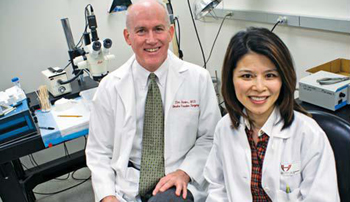Timothy Baxter, M.D., senses the fear when patients learn they have aortic aneurysms.
Surgical repair is immediate if the abnormal bulge reaches 5.5 centimeters – equivalent to the short end of a credit card. Until then, there is no treatment, only watchful waiting.
 |
Timothy Baxter, M.D., and Wanfen Xiong, M.D., Ph.D. |
Now, Dr. Baxter and his colleague, Wanfen Xiong, M.D., Ph.D., may have an answer.
Using mouse models they developed in 2000, Drs. Baxter and Xiong have discovered that doxycycline, a common and inexpensive antibiotic, is effective in slowing or stopping the growth of aneurysms.
Pending grant approval later this summer, they will launch the first clinical trial in the United States for medical treatment of aortic aneurysms. Coordinated at UNMC, the 15-center trial would enroll 250 study participants in a two-year, double-blind study.
Participants would receive the doxycycline pill, which blocks enzymes that break down tissue and cause aneurysms to grow, or a placebo. CAT scans would follow every six months to monitor growth.
“If we could slow the growth, we might never need surgical intervention,” Dr. Baxter said, noting that small and slow-growing aortic aneurysms don’t rupture, but large and fastgrowing ones may.
|
Women account for about 20 percent of aneurysms.
“It’s considered a silent killer,” Dr. Baxter said, “because there are no symptoms until it ruptures. Most aneurysms we find by luck when imaging is done for other medical conditions.”
Ninety percent of these aneurysms are below the threshold for intervention at the time of detection. So, the game of wait-and see begins for an already anxious patient. The average growth for aneurysms is 2.5 millimeters per year. In mouse models, Dr. Baxter said, doxycycline slowed the growth by 40 percent.
In addition to treatment options, Drs. Baxter and Xiong want to develop markers to identity small aneurysms at earlier stages, as well as learn more about the genes involved.
“It would mean a lot if we could offer patients a more proactive treatment approach,” he said.
will this treatment work on other aneurysms throughout the body? also, will this treatment noursih aortic to return to normal? what I have expericed with a love ones enlarge artery is that there is still a high risk of stroke to happen when artiers remain enlarge? I hope your treatment works for the life challenges after having and, aneurysm is dramatic its a life of a on going roller coaster not knowing a good day from a bad! your love one is never the same after experiencing and, aneurysm of any kind.
thank you for update the web.site @ unmc your site as well as others help many patients understanding further treatments that are and can be available. I go to the unmc sites just to educate myself and find answers in understanding my husband's condition which is, living with and, enlarge artery in the neck which was and, aneurysm which they said will heal on its own..however, the side effects in healing is what I needed to understand to care for him and so the unmc site has improved and been very helpful for me and my husband to understand his condition. thank you and I hope more treatments will be available in the future. sincerely, aleigh
awesome good news…..no surgery……..and a medicine that will allow love ones to enjoy each other longer…..there is beauty in life after all………………..aleigh